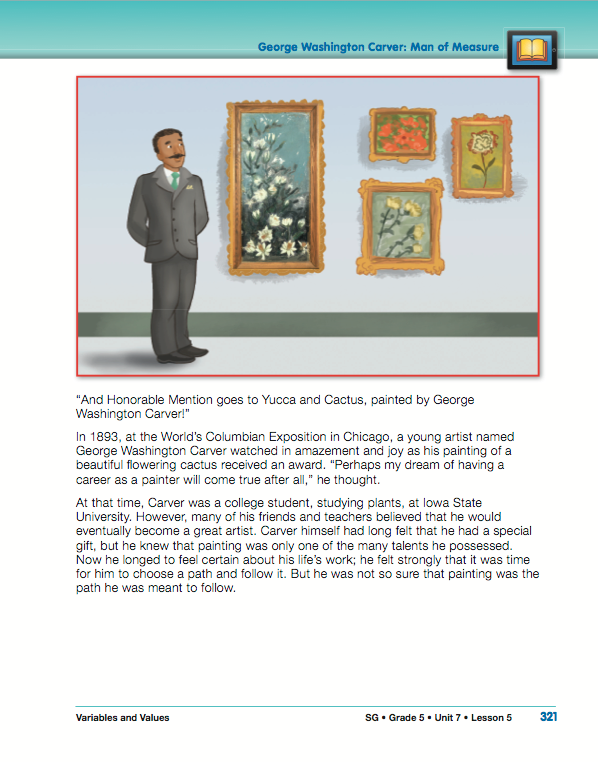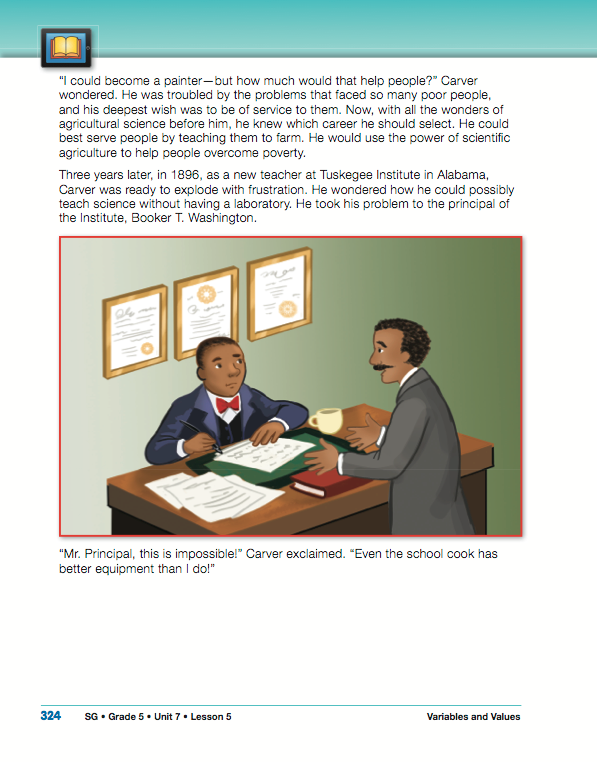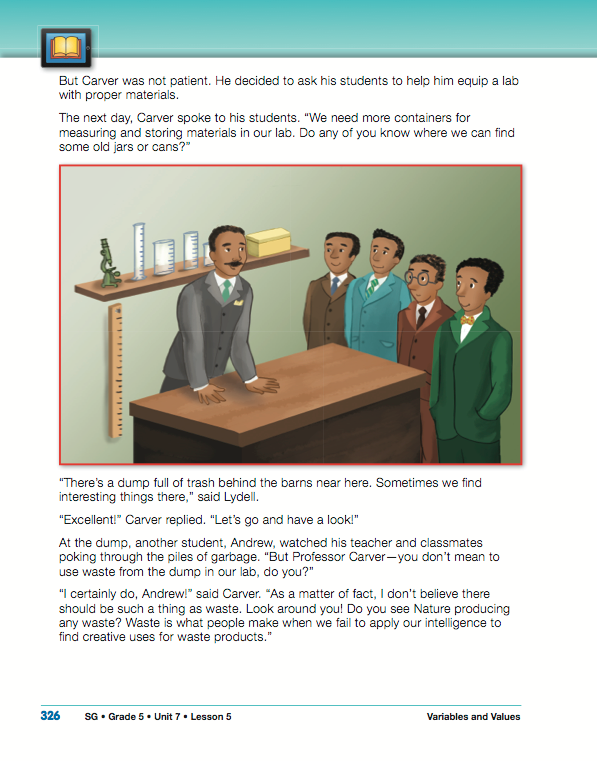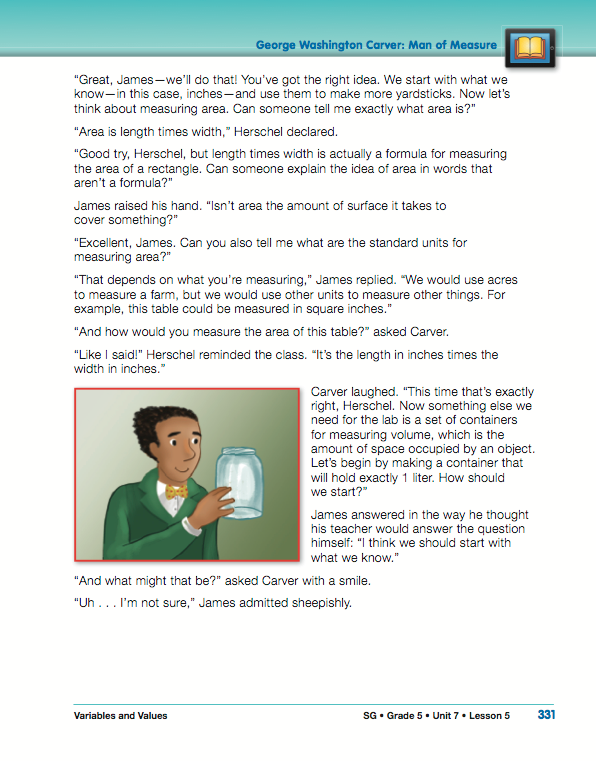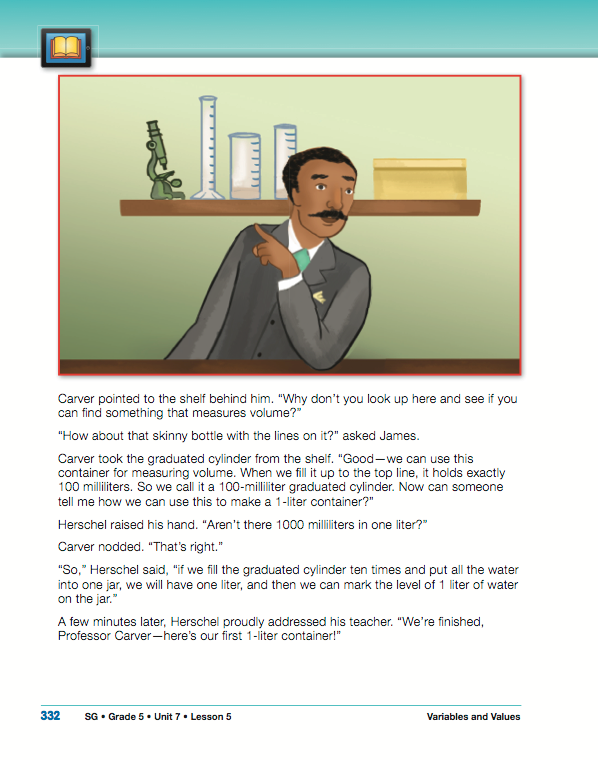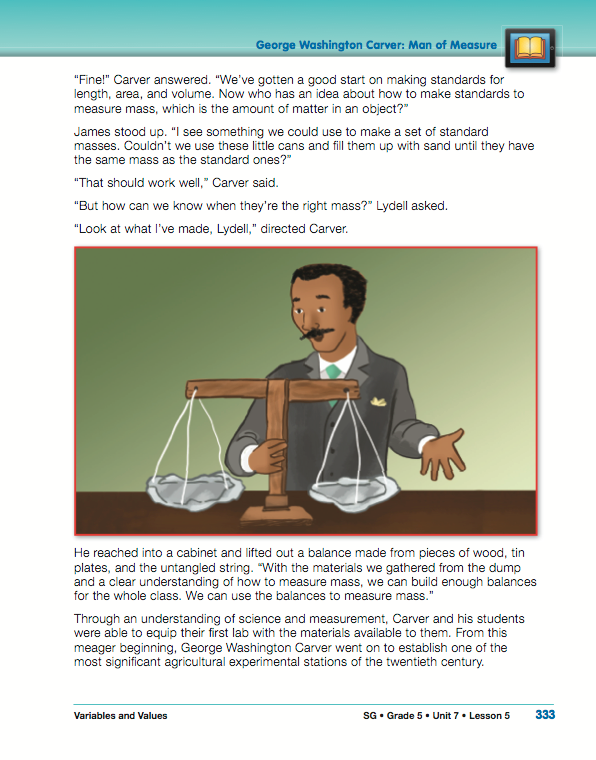Read and Discuss the Story. Direct students to the story, “George Washington Carver: Man of Measure,” on the Variables and Values pages in the Student Guide. This story is based on actual historical events in the life of George Washington Carver. Use the information in the Content Note to set the context for this story.
This story begins as George Washington Carver is visiting the World Columbian Exposition in Chicago in 1893. Carver is at the exposition because several of his paintings had been selected to be displayed at the Iowa pavilion.
While at the exposition, Carver is torn between a love for painting and a deeply felt need to serve people. He spends much of his time studying the exhibits at the horticulture and agriculture buildings. These exhibits convince him of the power of scientific agriculture to improve the lives of poor southern farmers. They also help him choose a life devoted to the study of agriculture rather than the life of an artist.
Ask students to read the story through once for enjoyment before using these or similar discussion prompts to provide a deeper understanding of the story and its application to mathematics.
Page 322
In 1893 the World Columbian Exposition, also know as the World's Fair, was held in Chicago, Illinois. The Columbian Exposition is of great historical significance because of the broad and powerful impact it exerted on a national and international scale. In many ways, the event represented a technological jump-start for the 20th century. Millions of people were exposed for the first time to scientific and technological advances like the electric light bulb.
- Why was the World Columbian Exposition such an important event? ( Possible response: Many important inventions and discoveries were showcased at the Exposition.)
- What were some of the new technologies that George Washington Carver saw? (Possible responses: telescopes, steam engines, printing presses, new seed varieties, new tools to improve farming)
Page 324
- What were the career paths that George Washington Carver want to pursue? (Carver was torn between becoming an artist and teaching agriculture.)
- How did George Washington Carver's visit to the World Columbian Exposition influence his decision about what career path he would take? (Possible response: George Washington Carver saw how much the poor farmers in the South could benefit from the new technologies. He wanted to be able to help people because he thought that the farms provided more opportunity than the cities.)
- What were the frustrations that George Washington Carver found with his career choice? (Possible response: When Carver got his job teaching at the Tuskegee Institute he did not have the equipment he needed to teach in his lab.)

Booker T. Washington wanted Carver to teach farmers how to increase their cotton production. Washington wanted the farmers to be able to make enough money to buy their own land and become self-sufficient. During the 19th and early 20th centuries, cotton was both a profitable and high-risk commodity for farmers. When all went well, there was an enormous pay-off. But there were also many things, such as drought and boll weevils (a grey beetle that infests cotton plants) that can damage a field of cotton. Farmers who planted all of their fields in cotton were taking a big gamble because if the cotton crop failed, they would have no money for essentials like food and housing.
Page 326
- What did George Washington Carver do to address his frustrations with his lab? (Possible response: He and his students went to the dump to collect different containers and items they could use for lab equipment.)
- What are the five variables Carver talks about in the story? (length, area, volume, mass, and time)
- What are standard units of measure? (Standard units of measure are specific units that are the always the same. For example, an inch will always be the same length.)
- Why are standard units of measure important to mathematicians and scientists? (Possible response: Standard units allow mathematicians and scientists to communicate what they have measured and what the results of that measurement are in a way that can be easily understood by others. Without standard units this communication would not be possible.)

Standard units are specified quantities used in measuring a variable. For example, centimeters and meters are used as standard units for measuring length. Standard units are set and maintained on a national and international level.
Page 331
- Length times width is the formula for area of a rectangle. How is the formula used in this story? (The formula is used to find the area of the lab table.)
- How is this formula useful and what are its limitations? (Possible response: The formula is a useful way to find the area of a rectangle. It is not useful for finding the area of other shapes such as circles, triangles, shapes composed of different shapes, or irregular shapes.)
Page 332
- What strategy did Herschel use to make a 1-liter container? (Possible response: Herschel started with what he already knew. He knew that he needed 1000 milliliters to make 1 liter. Since the graduated cylinder holds 100 milliliters he had to fill it to the top ten times and empty it into the jar.)
Page 333
- Explain and expand on James's idea for making standard masses. (Possible response: James found some small tins with lids. He is going to fill each tin with the amount of sand needed so that its mass will be equal to the mass of one of the standard masses Carver brought from Iowa.)
- How did Professor Carver use the string he found and how did that help James finish his work? (Possible response: He used the string and some other things he found at the dump to make a balance. James can use the balance to make sure each of his homemade masses are equal to the mass of one of the standard masses.)

George Washington Carver was born in Diamond Grove, Missouri, around 1864. The date is not precisely known because Carver was born a slave. From this humble beginning, Carver went on to become a highly respected scientific thinker of the 20th century. After completing a master's degree in science at Iowa State in 1896, Carver moved to Alabama where he became Director of Agricultural Research at the Tuskegee Institute. George Washington Carver taught at Tuskegee and worked with poor Southern farmers until his death in 1943.













